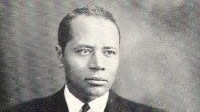Lawyer Charles Hamilton Houston’s Notable Achievements
Written by MasterClass
Last updated: Feb 22, 2023 • 4 min read
Charles Hamilton Houston was an educator and lawyer who helped train a generation of Black lawyers and won cases that helped prove racial segregation unconstitutional.
Learn From the Best
Who Is Charles Hamilton Houston?
Charles Hamilton Houston was a Black civil rights lawyer who played a critical role in dismantling Jim Crow laws, including helping to document and challenge racial segregation in public schools and in housing covenants. Charles Houston’s contributions laid the groundwork for the landmark Brown v. Board of Education (1954) case that would end racial segregation in the United States, which is how he earned the title of “the man who killed Jim Crow.”
Brief Biography of Charles Hamilton Houston
From growing up in Washington, DC, to his impact on landmark cases, here’s a look at Houston’s life:
- Early life and education: Charles Houston was born in 1895 in Washington, DC, where he grew up attending segregated schools. In 1911, after graduating high school at 15, he went on to study at Amherst College, where he was a member of the honor society and became the valedictorian. After college, he returned to Washington, DC, to teach English at Howard University.
- Service in the US Army: Charles Houston entered the racially segregated US Army in 1917 and served as a second lieutenant in France. He also served for a short time in the legal arm of the US Army as a Judge Advocate, where he experienced first-hand the prejudice against Black Americans. He left determined to further his education in law so that he could advocate for those who could not defend themselves or who faced racial discrimination.
- Postwar education: After World War I ended in 1919, Charles Houston studied at Harvard Law School, where he graduated cum laude and served as Harvard Law Review’s first Black editor. After graduating from Harvard University, he completed his education in Spain at the University of Madrid and became accepted to the American Bar Association in Washington, DC.
- Career and death: Charles Houston joined his father’s law firm in Washington, DC. He then went on to join the faculty at Howard University School of Law, and during his time there—from 1929–1935—he developed the program into one of the nation’s largest training programs for Black lawyers. In 1934, Houston became a special counsel to the National Association for the Advancement of Colored People (NAACP) and began an initiative to challenge the “separate but equal” doctrine of racial segregation. His work included documenting racial segregation in the American South and winning landmark civil rights cases that would help lead to the end of racial segregation with the Brown v. Board of Education case, which came four years after his death from heart attack in 1950.
Notable Achievements of Charles Hamilton Houston
Charles Hamilton—famously quoted as saying that a lawyer was “either a social engineer or a parasite on society”—is a notable figure in US history for his victories in civil rights cases that proved Jim Crow laws unconstitutional. He posthumously received the NAACP's Spingarn Medal for his work in fighting racial discrimination. Learn more about his other notable achievements:
- He challenged racial segregation standards in school and housing. Charles Houston’s legal strategy for dismantling racial segregation was to prove that institutions did not provide equal pay or facilities for Black students and that the cost to implement the separate but equal standards was so high that institutions abandoned segregation entirely. He traveled across the American South with cameras and a team of young Black lawyers to document public school conditions and housing covenants that did not meet the basic qualifications of the separate but equal standards designated in Plessy v. Ferguson.
- He trained a generation of successful Black lawyers. Charles Houston spent much of his career as an educator—and during his time as vice-dean of Howard University Law School—creating a law program that received accreditation from the Association of American Law Schools and the American Bar Association and became one of the nation’s largest law school’s for training young Black lawyers. Many of the Black law students that underwent the program—including Thurgood Marshall, the first Black US Supreme Court Justice—would go on to play critical roles in dismantling Jim Crow laws.
- He won landmark cases that led to the end of segregation in the United States of America. In two of his early victories, Missouri ex rel Gaines v. Canada (1938) and University of Maryland v. Murray (1936), the court ruled that the schools did not provide comparable education for Black students. He would later win multiple cases in which he proved that Black clients had not received fair juries while on trial, including in Hollins v. State of Oklahoma (1935). He successfully argued in front of the United States Supreme Court in Hurd v. Hodge (1948) that housing restrictions against Black tenants were unconstitutional. Charles Houston passed away in 1950 from a heart attack, but these cases laid the framework for the landmark case Brown v. Board of Education (1954) that would prohibit racial segregation in public schools.
Learn More About Black History
There’s a lot of information that history textbooks don’t cover, including the ways in which systems of inequality continue to impact everyday life. With the MasterClass Annual Membership, get access to exclusive lessons from Angela Davis, Dr. Cornel West, Jelani Cobb, John McWhorter, Kimberlé Crenshaw, Nikole Hannah-Jones, and Sherrilyn Ifill to learn about the forces that have influenced race in the United States.
